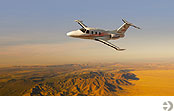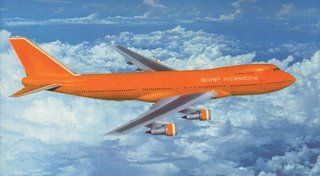 2006 may well be the year of dawn of a new era for business aviation, which has been anticipated ever since William Lear Jr. rolled out his first LearJet-23 in October 1963. Although successful (but accident-prone in the beginning: 10 of the first 100 produced were destroyed), Lear Jet was clearly meant for very rich people, who would fly from their New York, London, Moscow or Jeddah luxury homes to equally luxurious villas in Florida or French Riviera, before boarding a luxury yacht for a day trip with luxuriously beautiful women, who were plentiful in every respect. In other words, business jets have served a small number of super-rich, a market marginalised by the scarcity of money.
2006 may well be the year of dawn of a new era for business aviation, which has been anticipated ever since William Lear Jr. rolled out his first LearJet-23 in October 1963. Although successful (but accident-prone in the beginning: 10 of the first 100 produced were destroyed), Lear Jet was clearly meant for very rich people, who would fly from their New York, London, Moscow or Jeddah luxury homes to equally luxurious villas in Florida or French Riviera, before boarding a luxury yacht for a day trip with luxuriously beautiful women, who were plentiful in every respect. In other words, business jets have served a small number of super-rich, a market marginalised by the scarcity of money.Meanwhile, the general aviation, which in the 1960s and -70s was optimistic, innovative and growing very fast, has gone into slumber from producing 18,000 aircraft in 1978 to the current annual production rate of 3,000 aircraft.
All that is about to change, if we believe the enthusiastic entrepreneurs working on a concept of Very Light Jet (VLJ). People like Vern Raburn, the CEO of Eclipse Aviation and a former IT high-flyer, who has worked previously e.g. with such computer wizards as Bill Gates and Paul Allen.
It can be quite confidently predicted that, overall, air traffic will continue to grow as long as there is fuel to be burned. There have been only two short periods in the history of air traffic, when the growth rate was negative: in 1991 due to the first Gulf war and in 2001-2002 in the aftermath of 9/11 and outbreak of SARS.
 Picture: Braniff Orange Giant Boeing 747
Picture: Braniff Orange Giant Boeing 747Obviously, the growth rate for, say, the period up to 2025 is difficult to determine exactly. Generally speaking, the airline operators themselves dare not see or forecast beyond something like half a dozen years ahead. There is always the fear of economic failure, which is threatening even the most robust looking airlines. Who could have seriously predicted that companies like Braniff, PanAm, TWA, Swissair or even that joke of an airline business, the Belgian national carrier Sabena, would not exist in 2006. One would have thought that somebody could’ve bailed them out before letting them go under. Alitalia may be next.
But under they went. And consequently, it would be foolish to believe the predictions made by the airline industry.
The same is probably not true of the aircraft manufacturing industry. There are really only two serious players there, Boeing and Airbus, both (allegedly) clandestinely subsidised by the respective governments, which will make sure that they – and their jobs – not only exist for the foreseeable future, but will also thrive. And that makes their predictions somewhat more trustworthy.
Boeing Current Market Outlook 2005 predicts firstly that the world economies will grow by 2.6 % during the next 20 years. And secondly that the passenger traffic growth will average 4.8 % for the same period.
Currently there are some 16,800 passenger aircraft flying around the world. In twenty years that number will be something like 35,300, of which 24,700 are new additions or replacements for the ageing fleet (of some 6,000 aircraft). Thus about 60 % of the current fleet will still be flying 20 years from now. Little over half of the new aircraft would be for the American market.
Business aviation in Europe, compared to the USA, is rather limited for reasons such as restrictive allowance for use of airports and even parts of the European airspace. Flying in Europe has always been more government controlled that in the States. Most of the major airlines have been publicly owned and fiercely protected by their owners, the States. That has obviously changed and the airlines – whether publicly or privately owned – are supposed to compete with each other on equal basis and have to survive without generous support by the European taxpayer.
The loss of subsidies has resulted in disappearance of many city-pairs that were traditionally served by the government subsidised airlines making financial losses in flying those routes. The established airlines, including the low-cost carriers like Ryanair, in Europe now serve something like 30,000 city-pairs (3,000 of those only once a week and only 1,000 served daily), three times fewer that the business aviation, which serves some 100,000 city-pairs (albeit most of those only once a week or less). One problem of business aviation has been the lack of viable aircraft types. Business jets are very expensive and propeller-driven aircraft too slow. That is about to change.
Eurocontrol, sponsored by one of the few visionaries of European aviation, Lex Hendriks, the Head of Airspace Flow Managemend and Navigation Business Division in Eurocontol headquarters in Brussels, has just published a report entitled Getting to the Point: Business Aviation in Europe that promises a much brighter future for this sector of aviation business. It is predicted that its growth rate will be much higher than in airline industry, perhaps as high as 7 % a year for the next 10 years. The imminent introduction of VLJs may increase this even further.
 Picture: Cessna Citation Mustang
Picture: Cessna Citation MustangThe first of the VLJs to be certified by FAA in the USA will be Eclipse 500, expected to be approved in June or July 2006 and to start deliveries in the States at the end of 2006 or early 2007. The European certificate (by the European Joint Aviation Authority, JAA) is expected by the end of 2006. Although Eclipse 500 will be the first VLJ to be certified, it will not be the only one. Cessna Mustang is hot on the heels of the Eclipse jet, certification still in 2006 and first deliveries at about the same time as its early rival. The Diamond Aircraft Industries are developing their own, even smaller VLJ called D-Jet. The first flight was in April 2006 and certification is expected at the end of 2006 or in 2007. And there are other hopeful manufacturers as well
Clayton M. Christensen coined a term “disruptive technology” to describe a new development that has a major impact on a given market by introducing a product that is often “cheaper, simpler, smaller and more convenient to use”. If successful through consumer acceptance, such technologies have a potential, in time, to bring major changes to industry. VLJ would seem to fit well in that definition. Of course, only the time will tell, if that actually happens.
In the case of VLJs, if they are successful, this disruption may mean that a small portion of passengers now flying with the established airlines shift to service offered by VLJ operators, and that a large number of VLJs operating at big airports and in the common airspace would interfere with operations of airlines that, obviously, will continue to be regarded as the primary users of the common airspace.
The VLJs offer a service that is a cheaper, simpler, smaller and convenient point-to-point form of air travel. New kinds of air service may be established, such as air taxi operations for which seats (up to 4 or 5 passangers) would be sold on availability bases. Such as the service offered by a Florida-based company DayJet™ Corporation, who are a sort of a launch-customer for Eclipse 500 and already have firm orders for some 300 of them for the company’s new "Per-Seat, On-Demand" –jet service. Similar services may also be offered in Europe.
Some VLJ buyers might want to replace their privately-owned existing Cessna jets or twin- or single-engine piston aircraft with a small jet that can be operated by the owner as a single-pilot. At the time of writing this posting, it is expected that the VLJs will be certified for such operations. Currently, 750 orders (backed by non-refundable deposits) for Eclipse 500 (of total of more than 2000 orders) are from owner-pilots, many of them replacing their current piston-engine aircraft with a VLJ.
VLJs are not cheap. Eclipse 500 is now going for 1.4 million US dollars. Even smaller and single-engine Diamond D-Jet will cost 1 million US. On the other hand, their operating cost per air kilometre could be as low as 60 or 70 US cents, costing the paying customer perhaps 3 dollars a kilometre. This would be comparable to or even less than the cost of a full-fare economy airline ticket. Time saved by passengers, by not using major airports and thus avoiding delays on the ground and even in the air in crowded TMAs, would make VLJ flights even more attractive.
The FAA Joint Planning and Development Office (JPDO) (see Next generation system integration plan, 2004, in pdf-format) estimates that, if 2 % of airline passengers decide to avail themselves with the new service, there would be a need for three times more flights to carry those passengers compared to existing air services. That may have a disruptive effect on the existing Air Traffic Control system, which, in effect, remain basically the same at least until the year 2015. The VLJs are slower than airlines, in cruise 0.64 M compared to airliners' 0.82 or so and they are competing for the same altitudes (up to FL 410). This may cause some problems for ATC. Bo Redeborn, Director of Air Traffic Management Strategies at Eurocontrol has said, cryptically, when speaking of the future of business aviation in Europe: "Growth on these levels presents a number of challenges for air traffic management."
Some estimates have predicted that the number of VLJs in the USA by 2015 may be as high as 8,000 and that in Europe the number would be about 3,500, which is surprising considering that European Union generates 39 % of the world’s GDP (USA’s share is 33 %). Traditionally, USA has always been ahead of Europe in business aviation. USA’s share of the current business jet fleet is 72 % against Europe’s 13 %. Therefore, it would seem that Europe has a huge potential for buying general aviation aircraft in general and – considering European crowded roads and major airports – especially the VLJs.
 Their introduction would mean changes to how Europe’s skies are controlled, but that, Dear Reader, is another story.
Their introduction would mean changes to how Europe’s skies are controlled, but that, Dear Reader, is another story.Picture: Diamond Industries D-Jet
No comments:
Post a Comment